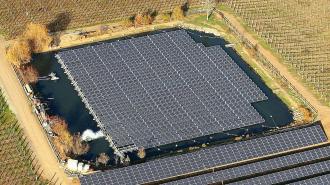A German company will switch on a floating solar power plant it has built on a quarry lake, a rapidly-installed, renewable technology it says could help wean the country off Russian fossil fuels.
BayWa r.e. said the photovoltaic (PV) plant at the family-owned Quarzwerke in the western German town of Haltern am See will be able to provide 3 megawatts (MW) of power, equivalent to a typical onshore wind turbine.
The plant, with 5,800 modules on 360 floating elements, will go into service on May 24.
It comes as Germany scrambles to find alternative sources of energy and phase out its reliance on Russian oil and gas in the wake of Moscow’s invasion of Ukraine.
Toni Weigl, head of floating-PV product management at BayWa r.e., said Germany could house around 20 gigawatts (GW) of solar energy on water.
“Floating PV systems are environmentally friendly and have the advantages of simpler and faster installation,” he said.
The floating panels will use space that would otherwise lie idle at Quarzwerke, a foundry sands maker in a densely populated region.
They will save 1,100 tonnes of carbon dioxide emissions a year compared with the same amount of power produced from fossil fuels.
BayWa r.e. plans to bring 1 GW of renewable capacity online this year, it said on Feb. 24 as it published 2021 financial data. The firm focuses on onshore and offshore wind, and also arranges green power purchasing deals for multinational companies.
Parent company BayWa last month said its earnings before interest and tax jumped 26% in 2021 to 267 million euros ($290 million), with 135 million euros from BayWa r.e.
Swiss infrastructure investor Energy Infrastructure Partners owns 49% of BayWa r.e.
Republished with permission of the World Economic Forum under a Creative Commons license. Read the original article.
